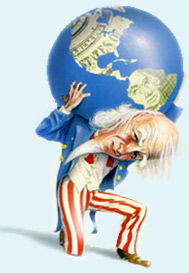
|
 |
 |
 Business News | January 2005 Business News | January 2005  
U.S. Trade Gap Widened to Record $60.3 Billion
 Bloomberg Bloomberg

The U.S. trade deficit unexpectedly grew to $60.3 billion in November, the widest ever, as demand for oil and consumer goods drove imports to a record. Exports fell.

 The trade gap increased 7.7 percent from the previous record of $56 billion in October, the Commerce Department said in Washington. The trade gap with China held close to the previous month's record. The trade gap increased 7.7 percent from the previous record of $56 billion in October, the Commerce Department said in Washington. The trade gap with China held close to the previous month's record.

The $561.3 billion deficit through November exceeds the record for all of 2003. A rebound in consumer spending during the second half of last year boosted demand for imported products in the world's largest economy. Slower growth in Japan and Europe than in the U.S. may have limited demand for American goods, economists said.

"The U.S. is growing faster than nearly everyone else, and that kind of dynamic means that imports will be growing faster than exports for some time, despite a weaker dollar," said Nariman Behravesh, chief economist at Global Insight Inc. in Lexington, Massachusetts.

The dollar weakened against the euro and yen after the report. The euro climbed to $1.3205 at 8:42 a.m. Washington time from $1.3107, and the yen to 102.57 per dollar from 103.32.

Imports rose 1.3 percent for the month to $155.8 billion. Exports fell 2.3 percent, the first decline since June, to $95.6 billion. Exports were a record $97.8 billion in October.

The trade deficit is a negative in the Commerce Department's estimates of U.S. gross domestic product. A Bloomberg News survey before today's report called for the economy to grow at a 3.9 percent annual rate in the final three months of 2004, compared with 4 percent in July-September.

Behravesh said the trade deficit will "shave a few tenths of a percent" from fourth-quarter growth.

Expectations

Economists expected the deficit to narrow to $54 billion for the month compared with a previously reported $55.5 billion gap in October, according to the median estimate of 70 forecasts in a Bloomberg News survey.

The value of oil imports rose in November to a record $13.4 billion from $13.2 billion. The U.S. imported 326.5 million barrels in November, compared with 315.8 million in October, when the futures price climbed to a record. The average price of imported oil dropped to $41.15 a barrel from $41.79.

Consumer goods imports rose 1.1 percent to a record $32.4 billion. Food imports and imports of industrial supplies, which include oil, also were the highest ever.

Imports of autos and parts fell 2.3 percent to $19 billion in November. Capital goods imports were little changed at $29.7 billion.

Exports

Wholesalers rebuilt inventories at a stepped-up pace in October and November after consumer spending grew in the third quarter at a 5.1 percent annual rate, the fastest in almost three years, up from 1.6 percent in the second.

U.S. exports of consumer goods fell 2.6 percent to $8.6 billion. Foreign businesses also bought 5.1 percent less of capital goods. Services were a strong point, with exports rising to a record $29 billion.

Rising imports from China have added to the U.S. trade deficit and caused friction between the two countries.

The trade deficit with China narrowed to $16.6 billion from a record $16.8 billion. For the year, the trade gap with China is $147.7 billion, about one-fourth the U.S. deficit with all countries.

China

The U.S. is pressing China to change the yuan's decade-old peg of about 8.3 to the dollar, saying the fixed rate depresses the yuan's value, giving Chinese manufacturers an unfair advantage by making their goods cheaper abroad.

A congressionally mandated commission reported yesterday that China's growing trade surplus with the U.S. has cost 1.5 million U.S. jobs since 1989.

Lawmakers and manufacturers are also urging China's government to curb subsidies and clamp down on counterfeiting of trademarked goods.

"When China's leaders fail to produce results on the points of friction in our trading relationship, their failure only empowers those critics within the U.S. political system," Commerce Secretary Donald Evans said today in a speech to the American Chamber of Commerce in Beijing.

Other Countries, Regions

The shortfall with Japan, at $7.3 billion, was the highest since October 2000.

The deficit with Canada, the largest U.S. trading partner, widened to a record $7.3 billion from $5.7 billion. The gap with Mexico narrowed to $3.9 billion from $4.4 billion.

The deficit with the European Union widened to $10 billion from $8.9 billion.

A decline in the value of the U.S. dollar and slower growth in consumer spending may trim the U.S. trade deficit by the end of this year, economists said.

The dollar lost 4.6 percent of its value against a basket of currencies from major trading partners in 2004, making imports more expensive and U.S. exports cheaper.

"From the perspective of a manufacturer in North America, a somewhat weaker dollar makes us more competitive, and it's going to be favorable for the manufacturing economy into 2005," John Surma, chief executive of U.S. Steel Corp., said in an interview last week. The Pittsburgh company is the largest steelmaker in the Americas.

Through November, U.S. exports of iron and steel mill products were $4.6 billion, up $774 million from the same period a year earlier. Semiconductor exports were up $2.2 billion to $44.1 billion.

"In general, it was strength throughout the quarter, throughout the world across most products," Andy Bryant, chief financial officer of Intel Corp., said yesterday. The company, the world's largest maker of computer chips, said sales exceeded $9 billion in the fourth quarter and revenue was a record. | 
 | |
 |



